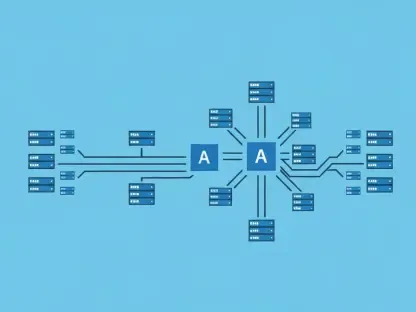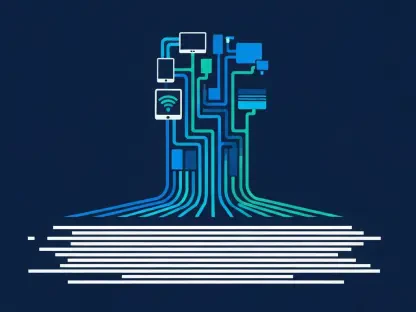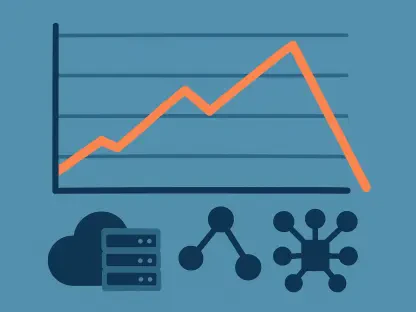In a shocking revelation, the cybersecurity community has uncovered a significant threat targeting contractor software through vulnerabilities in the Microsoft SQL Server (MSSQL) framework. This newfound threat is specifically exploiting general contractors involved in sectors such as plumbing, HVAC, and concrete. Researchers from Huntress first identified this alarming activity, prompting a deeper investigation that has yielded critical insights and recommendations.
Discovery of the Cyber Threat
Initial Detection by Huntress Researchers
On September 14, 2024, Huntress researchers detected unusual activities originating from the sqlservr.exe process. Suspicious commands involved in host/domain enumeration were executed, shedding light on potential malicious exploits. This discovery marked the beginning of an in-depth investigation into the root cause. The magnitude of the identified threat led researchers to delve deeper, seeking to understand the scope and mechanisms exploited by the attackers. Their findings pointed towards a concerted effort by cybercriminals to infiltrate contractor software platforms.
The initial clues indicated that the attack was not random but extremely targeted. Huntress researchers observed that sqlservr.exe activities included enumeration commands, suggesting a sophisticated attempt to map out the network environment. These findings raised immediate red flags, signaling a broader, systemic issue that warranted urgent analysis. As the team continued to investigate, more evidence surfaced, reinforcing the hypothesis that the cyberattack aimed at contractor-specific software solutions.
Anomalies and Red Flags
As Huntress researchers examined the unusual activities further, they began to recognize a pattern in the anomalies observed. The sqlservr.exe process exhibited behaviors consistent with a targeted cyberattack, primarily focusing on contractor software. These anomalous patterns included commands for host and domain enumeration—an indicator that the perpetrators were mapping out the network to identify vulnerable points for further exploitation.
The red flags raised by these activities led to a deeper investigation into the contractor software’s underlying architecture. The research efforts aimed to uncover how these exploits were being executed and identify potential mitigations. It became evident that the nature of the attack required a comprehensive understanding of both the software and the methods employed by the attackers. The urgency of the situation became more pronounced as investigators pieced together a clearer picture of the threat’s scope and potential impact on contractor industries.
Technical Aspects of the Vulnerability
Integration of MSSQL in Foundation Software
The discovered cyber threat significantly hinges on the integration of Microsoft SQL Server (MSSQL) within Foundation software—a widely used application in the construction industry. Foundation software relies on an MSSQL instance for its database management functions. Typically, such MSSQL databases are secured within internal networks, heavily protected by firewalls to prevent unauthorized access. However, the Foundation software incorporates features meant to facilitate mobile application access for its users, necessitating the public exposure of TCP port 4243.
The public exposure of TCP port 4243 was identified as a critical vulnerability. This particular port supports the mobile app’s remote access functionalities, but it also inadvertently opens a pathway for cybercriminals. This exposure increases the risk of unauthorized access, especially when combined with poor security practices like using default credentials or weak passwords. Understanding this integration and the resulting vulnerabilities helps shed light on how attackers can infiltrate these systems, offering valuable insights into preventive measures.
Privilege Escalation Risks
The MSSQL Server’s default system administrator account, commonly known as “sa,” is a fundamental aspect of the identified security weakness. This account comes with extensive administrative privileges, allowing it to execute shell commands and scripts, manage databases, and perform various critical system functions. Given these capabilities, the “sa” account represents a high-value target for threat actors. Once they gain access, they can control the system extensively, elevating their ability to cause widespread damage.
The risk of privilege escalation is exacerbated when security practices are lax. Cybercriminals often exploit two primary methods to infiltrate the system—brute-forcing the login credentials and leveraging default “sa” account credentials. The failed or weak attempt at securing this administrative account gives cybercriminals a comparatively straightforward path to take over the system. Once inside, the attackers can automate their malicious activities using scripts, amplifying their threat and potential impact.
Exploitation Mechanisms and Attack Vectors
Brute-Forcing and Default Credentials
A critical aspect of the attack mechanism involves cybercriminals exploiting weak security protocols through brute-forcing and default credentials. Brute-forcing is a method where attackers systematically attempt various passwords until they succeed in gaining unauthorized access. This method is particularly effective when users employ weak or predictable passwords. The second strategy involves leveraging default credentials, a more concerning tactic as it implies that many users have not changed the default “sa” account password, leaving the system wide open for easy penetration.
The ease with which cybercriminals can exploit these vulnerabilities is alarming. Both brute-forcing and default credential exploitation can grant attackers swift and unauthorized access to the system’s core functions. Once access is obtained, the threat actors are free to manipulate data, execute commands, and place malicious software, thereby compromising the entire network. This has highlighted a significant necessity for organizations to adopt better password policies and avoid using default credentials, creating a more secure environment.
Automated Attack Scripts
The subsequent phase of the attack involves the deployment of automated scripts by cybercriminals. These scripts are designed to streamline and optimize malicious activities, encompassing a variety of functions such as data exfiltration, system manipulation, and the establishment of persistence within the network. The automation of these tasks means that once attackers gain access, they can efficiently conduct their illicit activities with minimal direct intervention, maximizing the potential damage they can inflict.
Automated scripts play a pivotal role in modern cyberattacks, allowing attackers to carry out large-scale operations with enhanced precision and speed. The scripts can also be customized to the specific configurations of the targeted system, making them highly adaptable and difficult to counteract. This capability to automate attacks underscores the importance of having robust, multi-layered security measures in place. Regular audits and real-time monitoring can help detect and neutralize these scripted attacks more effectively, shielding organizations from severe, sustained cyber damage.
Targeted Industries and Impact
Vulnerable Construction Sectors
Cybercriminals have honed in on the construction industry, particularly those contractors using Foundation software for their operations. The targeted nature of these attacks can be attributed to the reliance of these sectors on specialized software solutions, which may not always incorporate the latest cybersecurity best practices. From plumbing to HVAC to concrete work, contractors rely heavily on effective software management solutions, making them prime targets for exploitation.
The construction industry, with its juxtaposition of large-scale projects and small subcontractors, presents a unique cybersecurity challenge. Many of these organizations may lack the resources or expertise to implement stringent cybersecurity measures, making them vulnerable. This sector-specific targeting underscores the need for a tailored cybersecurity approach that addresses the unique vulnerabilities and operational behaviors of construction-related businesses. Only through such targeted strategies can these industries safeguard their digital ecosystems from sophisticated cyber threats.
Broader Implications for Contractors
The implications of these attacks on the construction industry extend well beyond immediate operational disruptions. Financial losses, compromised project timelines, and eroded client trust represent just the tip of the iceberg. By bringing these systemic vulnerabilities to light, it becomes evident that the risk spans the entire operational spectrum. The revelations emphasize the need for contractors to consider advanced, industry-specific cybersecurity measures, protecting not only their digital assets but also their overall business operations.
The broader impact of such focused cyberattacks is a wake-up call for the entire industry. It highlights the necessity of proactive and adaptive cybersecurity measures tailored to the unique needs of contractor businesses. The disruptive potential of these cyber threats can significantly impede operational efficiency, resulting in substantial financial and reputational costs. Therefore, industry stakeholders must invest in comprehensive cybersecurity frameworks, continuous monitoring, and preventive strategies to mitigate these evolving threats effectively.
Mitigation Strategies and Recommendations
Credential Management and Rotation
To shore up defenses against such sophisticated cyber threats, organizations using Foundation software must prioritize updating and rotating their credentials regularly. Implementing robust password policies and ensuring that passwords are complex and unique can considerably mitigate the risk of brute-force attacks. Regularly changing passwords adds an extra layer of security, making it more difficult for attackers to gain unauthorized access even if they initially succeed in breaking through weaker defenses.
Credential management strategies must also include the use of advanced authentication methods such as multi-factor authentication (MFA). Employing MFA ensures that even if a password is compromised, additional verification steps are required to access critical systems. These measures significantly enhance security and reduce the likelihood of successful unauthorized access. By fostering a culture that values stringent password management and the adoption of advanced authentication protocols, organizations can better defend against these pervasive cyber threats.
Isolating Software Installations
A critical mitigation strategy highlighted by cybersecurity experts is keeping software installations disconnected from the Internet whenever possible. This measure drastically reduces the potential for exploitation via publicly accessible ports, such as TCP port 4243 used by Foundation software for mobile access functionalities. Isolating software installations from the Internet means that even if vulnerabilities exist, the attack surface available to cybercriminals is significantly minimized, offering a stronger security posture.
Furthermore, adopting a principle of least privilege can enhance software isolation measures. By ensuring that only necessary system components and user accounts have access to critical functions, organizations can limit potential security breaches. Network segmentation and rigorous firewall policies can further help to isolate vulnerable systems, making it exceedingly difficult for attackers to penetrate multiple layers of defenses. Implementing these measures holistically can fortify an organization’s defense, safeguarding against a wide range of cyber threats.
Comprehensive Security Measures
Contractors and organizations in the construction industry are urged to adopt comprehensive, multi-layered security measures tailored to their specific operational needs. Integrating advanced threat detection systems can provide real-time monitoring and quicker responses to potential security incidents. Regular security audits can uncover weaknesses in the system, offering an opportunity to rectify them before they can be exploited. Investing in cybersecurity training for employees is also crucial, as human error often serves as a pathway for cyber threats.
Comprehensive security strategies should not stop at technology; they must also encompass policies and procedures that foster a culture of security awareness. Regular updates and patches to software systems, coupled with robust incident response plans, can fortify defenses. Equipping organizations with the right tools and knowledge is vital for defending against evolving cyber threats. By staying vigilant and adapting to new security challenges, organizations can better protect their digital assets and ensure the continuity of their operations in an increasingly complex cyber threat landscape.
Conclusion Note
In a startling development, the cybersecurity field has identified a major threat targeting contractor software through weaknesses in the Microsoft SQL Server (MSSQL) framework. This threat specifically exploits vulnerabilities affecting general contractors working in industries like plumbing, HVAC, and concrete. The initial discovery was made by researchers at Huntress, who uncovered this alarming activity and triggered a comprehensive investigation. The investigation provided crucial insights and detailed recommendations on how to mitigate the risks.
This security issue underscores the importance of robust cybersecurity measures, especially for industries that may not traditionally focus on digital protection. As contractors increasingly rely on digital tools and software to streamline their operations, they become more vulnerable to cyber attacks. Organizations are advised to implement stronger security protocols and stay vigilant about updates and patches that address these vulnerabilities. The research from Huntress serves as a critical reminder of the evolving nature of cyber threats and the need for ongoing vigilance and proactive measures to protect sensitive information and maintain operational integrity.









